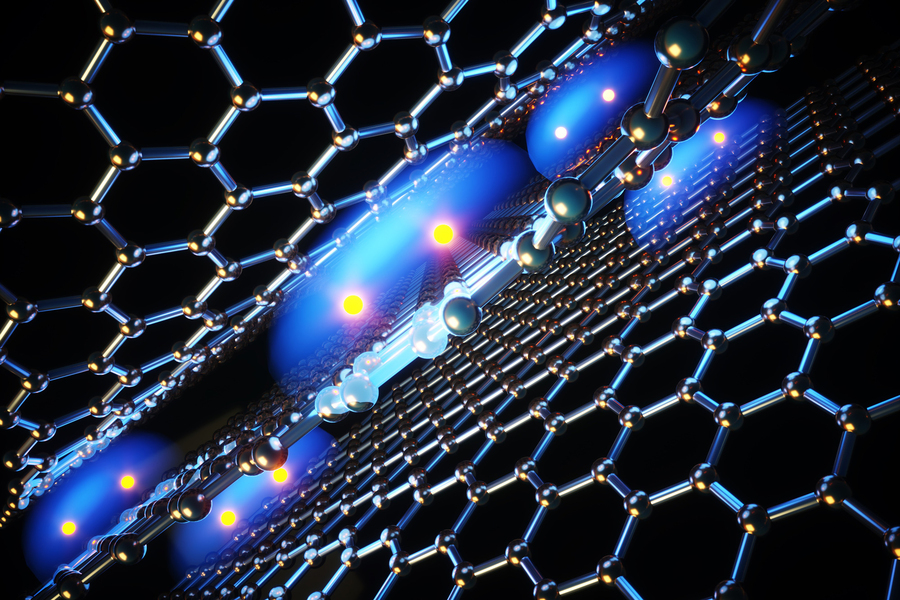Twisted graphene superconductors are at the forefront of cutting-edge research in superconductivity, captivating scientists with their potential for groundbreaking technological advancements. This remarkable material combines the remarkable properties of graphene with a unique twisting technique that enhances electron pairing, paving the way for innovative energy-efficient technology. Recent studies showcase how these twisted structures could revolutionize applications like lossless power transmission, levitating trains, and next-generation quantum computing. As researchers delve deeper into the intricate dance of electrons in these superconductors, they unveil promising insights that could redefine our understanding of quantum mechanics. With the potential to transform diverse fields ranging from energy to space exploration, twisted graphene superconductors represent an exciting frontier in graphene research and superconductivity.
Superconducting materials, particularly those derived from twisted graphene configurations, are gaining increasing attention for their exceptional capabilities in conducting electricity without resistance. The innovative method of layering and twisting graphene has revealed how such structures can facilitate the formation of electron pairs, leading to significant implications for energy-efficient systems. As scientists explore these remarkable substances, they uncover unique interactions at play within their atomic structure, which may provide insight into future advancements in lossless power delivery and other areas reliant on superconductive properties. The exploration of twisted graphene as a novel class of superconductors not only enriches our understanding of quantum physics but also opens doors to potentially transformative applications in modern technology.
The Breakthrough in Twisted Graphene Superconductors
Twisted graphene superconductors represent a groundbreaking advancement in the field of superconductivity, a phenomena where materials conduct electricity without resistance. This unique behavior is achieved through a carefully controlled arrangement of graphene layers, where a slight twist between them creates new electronic properties that were previously unattainable. The innovative research conducted by teams at Harvard and MIT is pivotal, as it reveals how the interactions of electrons in twisted graphene deviate from conventional superconductors, promising significant advancements in energy-efficient technology.
The implications of twisted graphene superconductors extend beyond mere academic curiosity; they could fundamentally change how we harness electricity. Current superconductors have limitations, but twisted graphene stacks show the potential for lossless power transmission, which could lead to the development of more efficient electrical systems. As researchers continue to explore these unusual superconducting behaviors, the potential applications range from improving power grids to enabling advanced levitating trains and enhancing quantum computing technologies.
Understanding Electron Pairing in Twisted Graphene
One of the most intriguing aspects of twisted graphene is the way electrons pair together. Instead of repelling each other as negatively charged particles would typically do, under the right conditions, electrons in twisted graphene form pairs that condense into a superfluid state. This pairing mechanism is a focus of intense research as it not only contributes to understanding superconductivity but also ties into quantum mechanics, which governs the behavior of particles at microscopic scales. The quest to decipher this ‘quantum dance’ of electrons could unlock new pathways for technological innovation.
By investigating the resonant vibrations of these paired electrons, researchers aim to gain deeper insights into the fundamental mechanisms at play. Techniques involving microwave illumination function similarly to musical instruments, allowing scientists to ‘listen’ to the behavior of the superfluid and discern the nature of electron interactions. These findings hint at directional attractive forces between electrons, reminiscent of features seen in high-temperature superconductors, and could reshape our understanding of superconducting materials in general.
Potential Applications of Twisted Graphene in Technology
The exploration of twisted graphene superconductors opens a myriad of possibilities for technological advancements. As energy-efficient technology continues to be a primary concern in today’s world, the ability to harness superconductors for lossless power transmission could revolutionize how we distribute electricity. Researchers envision a future where twisted graphene could contribute to creating circuits and power systems that waste virtually no energy, paving the way for sustainable energy solutions.
Moreover, the lightweight and ultrasensitive properties of twisted graphene superconductors could enable the development of advanced detectors for space exploration. NASA’s Jet Propulsion Laboratory hints at the potential for these materials to create highly efficient sensors capable of operating in the harsh conditions of space, where traditional electronics may fail. Such innovations could profoundly impact our capability to explore and understand the universe, proving that twisted graphene is not merely a scientific curiosity but a stepping stone towards future technologies.
The Role of Quantum Mechanics in Twisted Graphene
Quantum mechanics plays a crucial role in the behavior of twisted graphene superconductors. The unique interactions between electrons at very low temperatures lead to phenomena that challenge our understanding of conventional physics. In twisted configurations, the electrons somehow synchronize in a manner that produces superconducting properties unlike those observed in other materials. This quantum behavior highlights the importance of studying materials at the atomic scale to discern the rules that govern their interactions.
As researchers delve deeper into the quantum mechanics of twisted graphene, they are uncovering insights that could lead to new families of superconductors. The ability to control the interplay between electron movement and structural twists offers a rich avenue for experimentation and potential applications. Understanding these quantum interactions may not only enhance existing technologies but also lead to breakthroughs in entirely new fields rooted in the principles of quantum mechanics.
Twisted Graphene and Future Research Directions
The research into twisted graphene superconductors is still in its infancy, but the potential for future discoveries is vast. As scientists continue to explore the nuanced behavior of electrons within these materials, they hope to draw parallels with other two-dimensional superconducting systems. The relationship between graphene’s structural twists and its electronic properties is a fertile ground for further inquiry, and future studies could pave the way for the development of even more sophisticated superconducting materials.
Emerging technologies could benefit immensely from the insights gained through twisted graphene research. Whether it’s creating more efficient power transmission methods or improving levitating transport systems, the applications are boundless. Future research endeavors will undoubtedly focus on optimizing these materials for practical use, showcasing how fundamental science can translate into real-world technologies that drive innovation and sustainability in various industries.
The Significance of Graphene Research in Superconductivity
Graphene research has revolutionized our understanding of solid-state physics and materials science since its discovery in 2004. The unique properties of graphene, such as high electrical conductivity and strength, make it a prime candidate for various applications, particularly in superconductivity. Its layered structure allows for fascinating interactions when manipulated, and subsequent discoveries, such as those involving twisted graphene, continue to build on this foundation. The journey of graphene research reflects the dynamic nature of scientific inquiry in uncovering the mysteries of materials.
As researchers uncover new superconducting mechanisms within graphene, the implications for technology become increasingly promising. The interplay of quantum mechanics and material design in structures like twisted graphene may inspire innovative approaches to challenges in energy transmission and storage. Ongoing and future graphene investigations are critical to bridging gaps in our knowledge and expanding the horizons of superconductivity.
Challenges in Twisted Graphene Superconductor Research
Despite the promising avenues that twisted graphene offers, significant challenges remain in understanding and leveraging its superconducting properties. One such challenge includes the need for advanced experimental techniques to probe the behavior of electrons at the nanoscale. As researchers strive to measure and analyze the superconducting states, the complexity of these systems may complicate data interpretation and result in varied outcomes based on experimental conditions.
Moreover, scaling the production of twisted graphene materials for practical applications poses another hurdle. Researchers need to develop fabrication methods that maintain the specific orientations and layers crucial for achieving superconductivity. Overcoming these challenges is vital for harnessing the potential of twisted graphene superconductors in future technologies, particularly in fields like energy-efficient electronics and quantum computing.
Twisted Graphene: A Game Changer for Energy Efficiency
The advancements in twisted graphene superconductors may significantly contribute to the drive for energy efficiency in modern technologies. As global energy needs continue to rise alongside concerns about sustainability, superconductors that facilitate lossless power transmission can play a pivotal role in reducing waste. These materials could revolutionize electrical grids, reducing the loss of power during transmission and ensuring that more energy gets delivered where it’s needed most.
Additionally, the lightweight and strong properties of twisted graphene could promote advancements in portable electronic devices, leading to longer battery life and reduced energy consumption. In fields such as transportation, where energy efficiency is crucial, incorporating twisted graphene materials may lead to breakthroughs that significantly lower overall energy demands and environmental impacts.
Collaboration and Interdisciplinary Approaches in Graphene Research
Collaboration between institutions is a cornerstone of progress in twisted graphene research. The joint efforts of teams from Harvard, MIT, and Raytheon-BBN Technologies exemplify how interdisciplinary approaches can foster innovation in understanding complex phenomena like superconductivity. Engaging physicists, material scientists, and engineers enhances the breadth of research and accelerates the pace of discovery.
Moving forward, fostering partnerships across various fields will be essential for tackling the challenges posed by twisted graphene superconductors. By pooling resources and expertise, researchers can develop comprehensive strategies to explore the limitless possibilities that these materials present, ultimately leading to groundbreaking advancements in technology and our understanding of superconductivity.
Frequently Asked Questions
What are twisted graphene superconductors and how do they relate to superconductivity?
Twisted graphene superconductors are structures formed by stacking layers of graphene at specific angles, which enables unusual superconducting behavior. Unlike traditional superconductors, such as aluminum, twisted graphene exhibits unique electron interactions and pairing mechanisms that are influenced by quantum mechanics, making them a focal point in superconductivity research.
How do twisted graphene superconductors enhance energy-efficient technology?
Twisted graphene superconductors have the potential to significantly enhance energy-efficient technology by allowing for lossless power transmission. This characteristic can lead to advancements in various applications, including long-distance electricity delivery and energy-saving electronic components.
What role do twisted graphene superconductors play in quantum mechanics research?
Twisted graphene superconductors are pivotal in quantum mechanics research as they provide a unique platform to study electron pairing and phase transitions at low temperatures. Their unconventional superconducting properties challenge existing theories and offer insights into quantum phenomena, making them essential for future quantum computing advancements.
How might twisted graphene superconductors be used in levitating trains?
Twisted graphene superconductors can contribute to levitating trains by enabling magnetic levitation technology. Their ability to conduct electricity with zero resistance allows for efficient magnetic fields that can lift and propel trains with minimal energy loss, thus paving the way for faster and more efficient transportation systems.
What insights have researchers gained from studying twisted graphene superconductors?
Researchers have discovered that twisted graphene superconductors exhibit a ‘quantum dance’ of electrons where pairing mechanisms vary in directionality. This behavior mimics that of high-temperature superconductors, providing valuable insights into electron interactions and superconductivity, and paving the way for further innovations in material science.
What applications are envisioned for twisted graphene superconductors in space exploration?
Twisted graphene superconductors are envisioned to create ultra-sensitive, energy-efficient detectors for space exploration. Their lightweight nature and low power consumption make them ideal for use in the near vacuum of space, where high-resolution detection with minimal energy input is essential for various scientific missions.
Why is the study of twisted graphene superconductors important for the future of superconductivity?
The study of twisted graphene superconductors is crucial as it reveals novel superconducting properties that challenge traditional understandings. By uncovering the mechanisms behind their unique electron interactions and pair formations, researchers hope to unlock new pathways for creating advanced superconducting materials, which can revolutionize energy transmission and quantum technology.
| Key Points | Details |
|---|---|
| Introduction to Superconductors | Materials that transmit electricity without resistance, first discovered in 1911. |
| Twisted Graphene Behavior | Superconducting behavior in twisted graphene differs from conventional superconductors, leading to unique properties. |
| Research Findings | A ‘quantum dance’ of electrons occurs in twisted graphene, enabling superconductivity at low temperatures. |
| Applications | Potential for lossless power transmission, levitating trains, quantum computing, and energy-efficient space detectors. |
| Research Team | Collaboration among Harvard, MIT, and Raytheon-BBN Technologies to study twisted graphene stacks. |
| Future Prospects | Continued investigation into twisted graphene could enhance superconductivity understanding and technology. |
Summary
Twisted graphene superconductors represent a groundbreaking advancement in material science. By leveraging the unique properties of twisted layers of graphene, researchers are uncovering new superconducting behaviors that differ significantly from traditional superconductors. This development not only enhances our understanding of quantum mechanics but also paves the way for revolutionary applications such as lossless power transmission and advanced quantum computing technologies. With further research, twisted graphene superconductors may redefine energy efficiency and technological capabilities in various sectors.



